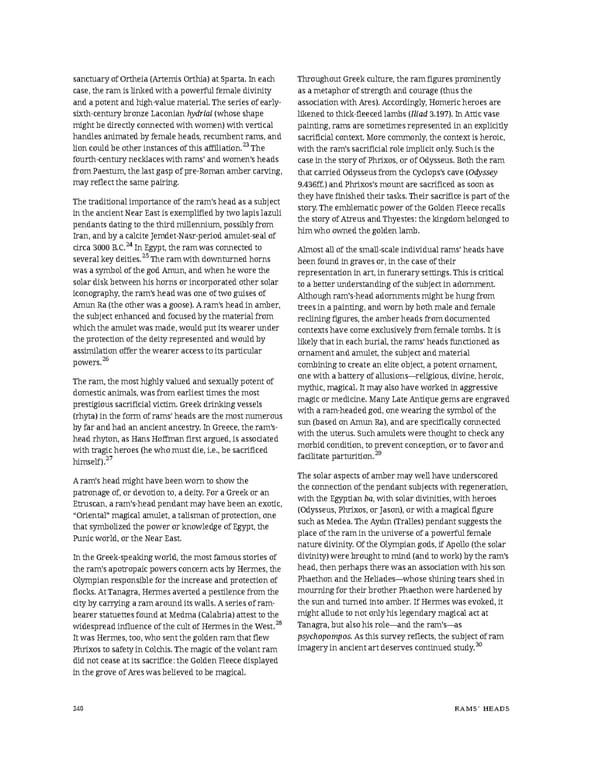sanctuary of Ortheia (Artemis Orthia) at Sparta. In each Throughout Greek culture, the ram figures prominently case, the ram is linked with a powerful female divinity as a metaphor of strength and courage (thus the and a potent and high-value material. The series of early- association with Ares). Accordingly, Homeric heroes are sixth-century bronze Laconian hydriai (whose shape likened to thick-fleeced lambs (Iliad 3.197). In Attic vase might be directly connected with women) with vertical painting, rams are sometimes represented in an explicitly handles animated by female heads, recumbent rams, and sacrificial context. More commonly, the context is heroic, lion could be other instances of this affiliation.23 The with the ram’s sacrificial role implicit only. Such is the fourth-century necklaces with rams’ and women’s heads case in the story of Phrixos, or of Odysseus. Both the ram from Paestum, the last gasp of pre-Roman amber carving, that carried Odysseus from the Cyclops’s cave (Odyssey may reflect the same pairing. 9.436ff.) and Phrixos’s mount are sacrificed as soon as The traditional importance of the ram’s head as a subject they have finished their tasks. Their sacrifice is part of the in the ancient Near East is exemplified by two lapis lazuli story. The emblematic power of the Golden Fleece recalls pendants dating to the third millennium, possibly from the story of Atreus and Thyestes: the kingdom belonged to Iran, and by a calcite Jemdet-Nasr-period amulet-seal of him who owned the golden lamb. circa 3000 B.C.24 In Egypt, the ram was connected to Almost all of the small-scale individual rams’ heads have several key deities.25 The ram with downturned horns been found in graves or, in the case of their was a symbol of the god Amun, and when he wore the representation in art, in funerary settings. This is critical solar disk between his horns or incorporated other solar to a better understanding of the subject in adornment. iconography, the ram’s head was one of two guises of Although ram’s-head adornments might be hung from Amun Ra (the other was a goose). A ram’s head in amber, trees in a painting, and worn by both male and female the subject enhanced and focused by the material from reclining figures, the amber heads from documented which the amulet was made, would put its wearer under contexts have come exclusively from female tombs. It is the protection of the deity represented and would by likely that in each burial, the rams’ heads functioned as assimilation offer the wearer access to its particular ornament and amulet, the subject and material powers.26 combining to create an elite object, a potent ornament, The ram, the most highly valued and sexually potent of one with a battery of allusions—religious, divine, heroic, domestic animals, was from earliest times the most mythic, magical. It may also have worked in aggressive prestigious sacrificial victim. Greek drinking vessels magic or medicine. Many Late Antique gems are engraved (rhyta) in the form of rams’ heads are the most numerous with a ram-headed god, one wearing the symbol of the by far and had an ancient ancestry. In Greece, the ram’s- sun (based on Amun Ra), and are specifically connected head rhyton, as Hans Hoffman first argued, is associated with the uterus. Such amulets were thought to check any with tragic heroes (he who must die, i.e., be sacrificed morbid condition, to prevent conception, or to favor and 27 facilitate parturition.29 himself). A ram’s head might have been worn to show the The solar aspects of amber may well have underscored patronage of, or devotion to, a deity. For a Greek or an the connection of the pendant subjects with regeneration, Etruscan, a ram’s-head pendant may have been an exotic, with the Egyptian ba, with solar divinities, with heroes “Oriental” magical amulet, a talisman of protection, one (Odysseus, Phrixos, or Jason), or with a magical figure that symbolized the power or knowledge of Egypt, the such as Medea. The Aydın (Tralles) pendant suggests the Punic world, or the Near East. place of the ram in the universe of a powerful female nature divinity. Of the Olympian gods, if Apollo (the solar In the Greek-speaking world, the most famous stories of divinity) were brought to mind (and to work) by the ram’s the ram’s apotropaic powers concern acts by Hermes, the head, then perhaps there was an association with his son Olympian responsible for the increase and protection of Phaethon and the Heliades—whose shining tears shed in flocks. At Tanagra, Hermes averted a pestilence from the mourning for their brother Phaethon were hardened by city by carrying a ram around its walls. A series of ram- the sun and turned into amber. If Hermes was evoked, it bearer statuettes found at Medma (Calabria) attest to the might allude to not only his legendary magical act at widespread influence of the cult of Hermes in the West.28 Tanagra, but also his role—and the ram’s—as It was Hermes, too, who sent the golden ram that flew psychopompos. As this survey reflects, the subject of ram Phrixos to safety in Colchis. The magic of the volant ram imagery in ancient art deserves continued study.30 did not cease at its sacrifice: the Golden Fleece displayed in the grove of Ares was believed to be magical. 240 RAMS’ HEADS
 Ancient Carved Ambers in the J. Paul Getty Museum Page 249 Page 251
Ancient Carved Ambers in the J. Paul Getty Museum Page 249 Page 251